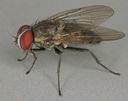Little House Fly
Fannia canicularis
Classification
- Phylum: Arthropoda
- Subphylum: Hexapoda
- Class: Insecta
- Order: Diptera
- Superfamily: Muscoidea
- Family: Fanniidae
- Genus: Fannia
- Species: canicularis
Pronunciation
How to pronounce Fannia canicularis: //ˈfæn.i.ə kəˌnɪk.jəˈlɛː.rɪs//
These audio files are automatically generated. While they are not always 100% accurate, they are a good starting point.
Images






Summary
Fannia canicularis, or the lesser house fly, is a small fly known for its tendency to enter buildings and its peculiar flight patterns. It reproduces in organic waste and can be a nuisance as well as a potential disease carrier. Its lifecycle and behaviors are adapted to thrive in situations with abundant decaying matter.
Physical Characteristics
The lesser house fly (Fannia canicularis) is a slim fly measuring 5–6 mm in length. It has brown-grey thorax with three black longitudinal stripes in males, which are less distinct in females. The eyes are holoptic (meet above) in males, while in females they do not meet. Its abdomen is translucent yellow at the first two segments with a dark-brown base. The halteres are yellowish.
Identification Tips
Look for a smaller size than the common house fly (3.5–6 mm). Notable for flying in jagged patterns and for having straight median wing veins.
Habitat
Commonly found in areas where there is decaying organic matter, excrement, and food waste.
Distribution
Spread worldwide, especially in urban areas and regions with a lot of organic waste.
Diet
Larvae feed on decaying organic matter, including carrion, excrement, and food waste.
Life Cycle
The life cycle takes approximately 2–4 weeks. Eggs hatch within 24 to 48 hours at 24–27 °C. Larvae develop for about six days before pupation, which lasts seven days or more.
Reproduction
Females lay eggs in batches of up to 50, potentially laying 2,000 eggs in total. The eggs can float in decaying organic matter, including feces and food waste.
Ecosystem Role
Considered possible disease carriers due to their feeding habits and ability to oscillate between excrement and human food.
Health Concerns
May be a carrier of diseases and pathogens due to their association with excrement and decaying organic matter.
Collecting Methods
- Trapping with baited traps
- Using nets in areas of known activity
Preservation Methods
- Preserving in ethanol
- Drying specimens for morphological studies
Misconceptions
Often mistaken for the common house fly due to similarities in appearance and behavior.
Tags
- Fannia canicularis
- insect
- diptera
- house fly
- pest
- disease vector